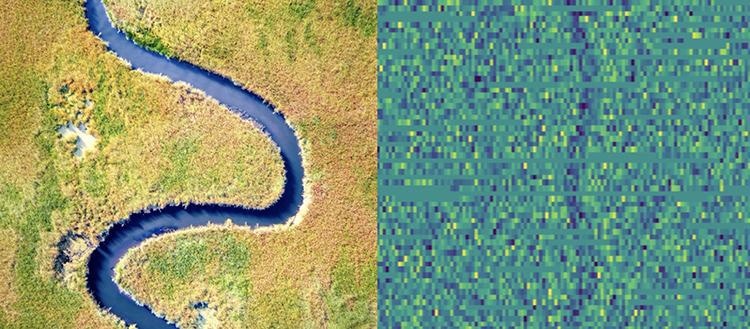Most of the exoplanets discovered so far have been discovered by applying the transit technique. This technique is based on a tiny eclipse caused when a planet travels in front of its star. The decrease in luminosity detected makes it possible to infer the presence of a planet and to guess its diameter, after the observations have been verified from time to time.
 The method uses a data representation where the presence of a planet (right) is seen as a river in the sky (left). The image on the right shows the measured luminous flux of the star Kepler-36 with the plot of eclipses due to the planet Kepler-36 b. (Image Credit: © Dave Hoefler).
The method uses a data representation where the presence of a planet (right) is seen as a river in the sky (left). The image on the right shows the measured luminous flux of the star Kepler-36 with the plot of eclipses due to the planet Kepler-36 b. (Image Credit: © Dave Hoefler).
However, theory estimates that in several planetary systems, interactions between planets modify this periodicity and make their discovery impossible. It is in this background that a team of astronomers from the University of Geneva (UNIGE), the University of Bern (UniBE) and the NCCR PlanetS, Switzerland, in partnership with the company Disaitek, used artificial intelligence (AI) applied to image recognition.
They programmed a machine to estimate the effect of interactions between planets, rendering it possible to spot exoplanets that were difficult to detect thus far. Details of the tools developed have been published in the journal Astronomy and Astrophysics. The tools could also be used on Earth to detect waste dumps and illegal dumps.
Discovering a planet using the transit technique is a long process. Detecting the signal produced by small planets in the data can be challenging, if not unthinkable with the usual methods, in the case where interactions between planets modify the periodicity of the transit occurrence. To overcome this challenge, it is essential to create tools that can take this effect into consideration.
This is why we thought of using artificial intelligence applied to image recognition.
Adrien Leleu, Researcher, Department of Astronomy, Faculty of Science, UNIGE
Adrien Leleu is also a researcher at NCCR PlanetS.
It is possible to teach a machine, using numerous examples, to take into consideration all the factors and estimate the effect of interactions between planets in a graphic representation of the induced effect. To achieve this, the astronomers teamed with the company Disaitek through the NCCR’s Technology & Innovation Platform.
An Artificial Neural Network Capable of Identifying Objects
The type of AI used in this project is a neural network whose aim is to determine, for each pixel in an image, the object it represents.
Anthony Graveline, President, Disaitek
Used in the perspective of an autonomous vehicle, this algorithm renders it feasible to identify the road, the signs, the pavement and the pedestrians observed by the camera. With regard to exoplanet detection, the aim is to establish, for each measurement of the star’s luminosity, if the eclipse of a planet is perceived.
Decisions are made by the neural network by cross-referencing all accessible observations of that star with the variety of configurations witnessed during its training.
From the first implementations of the method, we discovered two exoplanets – Kepler-1705b and Kepler-1705c – that had been completely missed by previous techniques.
Adrien Leleu, Researcher, Department of Astronomy, Faculty of Science, UNIGE
The planetary systems discovered in this manner are a gold mine for knowledge relating to exoplanets, and more predominantly of terrestrial-type planets, which are largely hard to define. The technique formulated not only makes it possible to predict the radius of planets, but also offers data on their mass, and thus on their composition and density.
The use of AI, in particular of ‘deep learning’ as in this paper, is becoming increasingly widespread in astrophysics, whether to process observational data, as we did here, or to analyze the results of gigantic numerical simulations producing terabytes of data.
Yann Alibert, Professor, University of Bern
“What we have developed in this study is a new example of the fantastic contribution that these techniques can make to our field, and probably to all fields of research,” Yann Alibert added.
Yann Alibert is also the Scientific Officer of the NCCR PlanetS.
Technology for Earth Observation
While this method is seen to be effective for astronomical explorations, it can also be just as beneficial for studying the Earth and its environment.
“In developing this technology, we quickly realised its potential for application to other problems for which a small amount of data is available,” explains Grégory Châtel, R&D Manager of Disaitek.
Using extremely high-resolution satellite images, Disaitek is currently using this AI to handle environmental issues, especially for finding illegal dumping. This menace, which is persistently on the increase, has no clear solution with traditional approaches.
Journal Reference:
Leleu, A., et al. (2021) Alleviating the transit timing variation bias in transit surveys. I. RIVERS: Method and detection of a pair of resonant super-Earths around Kepler-1705. Astronomy and Astrophysics. doi.org/10.1051/0004-6361/202141471.